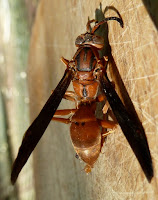
Hiking the woods on a dreary winter day, exciting finds are rare but I hit the jackpot with these beauties. They were in clusters on the lower eight feet of a shagbark hickory as well as a group on an exposed root covered with dead leaves. These are winter oyster mushrooms,
Pleurotus ostreatus as Mark Bower reminded me. These fresh specimens have a rich glistening brown top, darker than their more common summer cousins, the pale
Pleurotus pulmonarius.
 |
| Gills run all the way down the stalk |
 |
| Prying up the bark |
Both species grow shelf-like, initially somewhat firm but never hard like the brackett fungi. A distinctive feature of
Pleurotus species are the whitish gills that run down the stem to where they join the log.
These fresh specimens were firm enough that they were actually pushing up the slabs of bark.
Pleurotus species are
saprobic, meaning that they live on dead or dying wood, eventually producing a white rot. The front half of the tree was riddled with damage from a very determined pileated woodpecker, exposing the rot.
 |
| Crazy P. pulmonarius log |
For several years we had a mother lode of
P. pulmonarius on two long downed logs. There was even one day that Barb said "Don't bring in any more oysters!" but then she relented. Oysters are one of our favorite mushrooms, versatile in the kitchen as a substitute in Oysters Rockefeller, mixed in scrambled eggs or simply cooked in a little butter. (OK, sometimes a lot of butter.)
Speaking of butter, these mushrooms eat decaying logs but they aren't vegan. They need a little nitrogen to grow and they get it by becoming a predator. Like Audrey in Little Shop of Horrors, they can eat meat! Well, that is if you consider nematodes meat.
Rachael Sargent describes the process.
 |
| Pleurotus attacking a nematode- photograph by Greg Thorn |
"First, the oyster mushroom fungus plays a trick to attract nearby nematodes: it exudes chemicals that smell like dinner. Once a hungry nematode ventures close enough, the fungus uses a weapon called a “sticky nob,” which Thorn described as looking like a tiny lollypop. These nobs stick out like spines from the fungus' hyphae. In some carnivorous mushrooms, the ball of the lollypop has a glue that is especially sticky to nematode skin, but the oyster mushroom uses a different strategy. Its “sticky nobs” aren't sticky; instead, they have a toxin that paralyzes nematodes.
Once the nematode is immobilized, the fungus can harvest the victim’s nitrogen by sending hyphae through its body. Thorn described the moment of capture: “Watching through the microscope, you can see the nematode make one last pathetic attempt to wriggle away.”
We aren't the only species that eats oysters. There was one batch chewed down to a nubbin, possibly by a squirrel. There are at least
136 taxa of beetles that eat them, 60% of which are obligate mycetobionts (must live in fungi some time in their life cycle).
Note to self: Inspect the gills carefully.

Never eat any mushroom that hasn't been identified by an expert. The next time you eat a oyster mushroom, just remember to look for the beetles and think of the tiny worms that were digested by the mushroom. If that thought bothers you, contact me and we will take the oysters off your hands
.
 Gala Solari shared these pictures of a fern that was growing straight up a tree trunk. I sent the pictures to Justin Thomas (Institute of Botanical Training) who sent back this answer.
Gala Solari shared these pictures of a fern that was growing straight up a tree trunk. I sent the pictures to Justin Thomas (Institute of Botanical Training) who sent back this answer. 


























